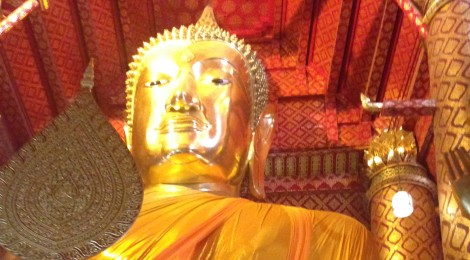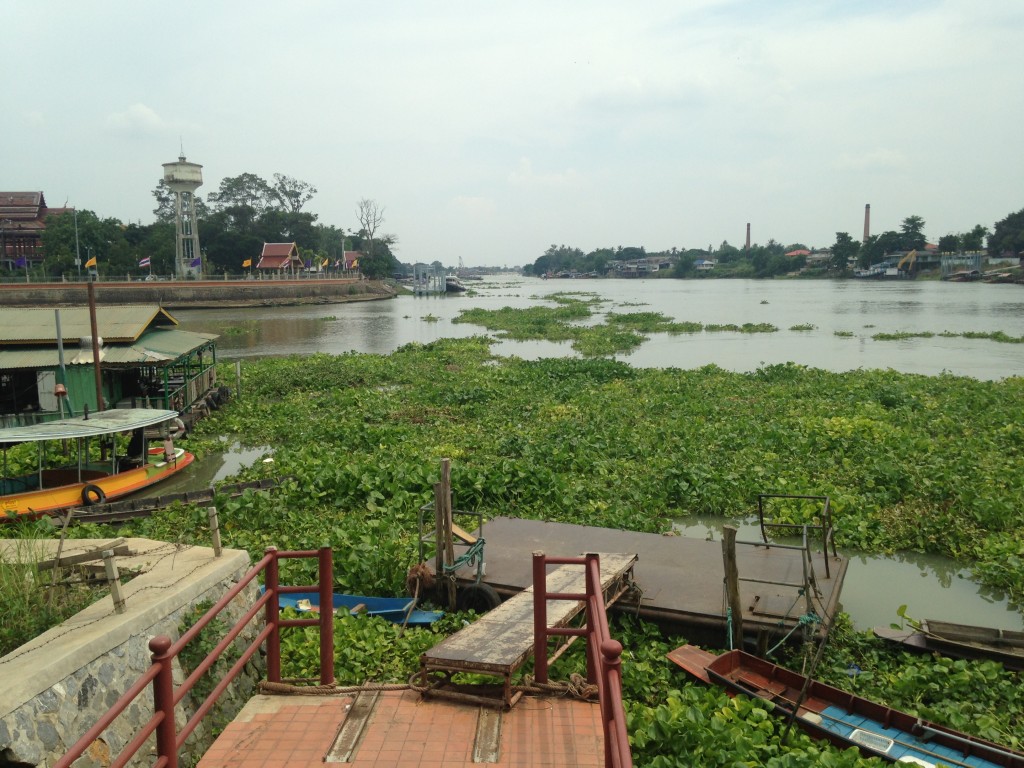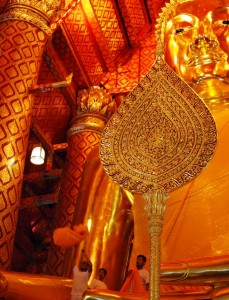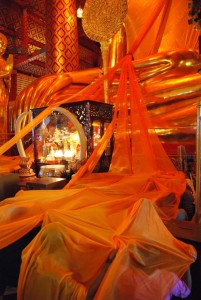
Golden Cloth Rays of Enlightenment
The city of Ayutthaya is on the map for its history, for its ruins, for the intimacy of its past. Our hostess calls it “a quiet temple town,” and her softly accented English is precise, correct.
Except.
Except we cross the eastern bridge and leave the safety of the island. We walk south under the hot afternoon sun to Wat Phanan Choeng where the Chao Phraya and the Pa Sak meet.

The Confluence of the Chao Phraya and the Pa Sak as seen from Ayutthaya. A bit of Wat Phanan Choeng is visible in the upper left. None of the boats pictured, were the outboard-motor ferry we were searching for. Enlightened as a result of our temple visit, we located the ferry on our way home. Click the photo to enlarge.
Not a quiet temple. Bus parking. With buses. Hubub. People buying and lighting incense. Buddha statues and charms for sale. An area of ever-burning oil lamps where oil can be purchased and added. Do your part to keep the spiritual energy flowing.
We do. We remove our shoes. We enter.
Where is the giant bronze Buddha we’ve heard about, struck by lightning, the largest seated Buddha in Thailand? Work towards the center. Is that it? We peer over the crowd and through an almost closed doorway. Half a dozen men, looking minuscule, are swarming over a statue. Are they polishing it? No, it’s robed. Like many Buddha statues in Thailand, a saffron cloth is draped over its left shoulder. It’s must be a gigantic piece of cloth in this case, and the men appear to be rigging ropes over that same shoulder.
Are they changing the Buddha’s clothes? Is it Buddha laundry day?
It appears likely to remain a mystery. It appears the inner sanctum is closed to the crowd. We turn our attention to the north, were an anteroom offers a smaller, hopefully equally interesting idol.
Alison tugs my arm. “They opened it,” she pulls me back toward the center. The crowd is flooding in.
We also flood.
Through the tall, tall door that made the statue seem normally proportioned. Now we get a sense just how BIG the Buddha really is. It feels like he might legitimately date the Statue of Liberty. The crowd carries us a little right of the center. A stick-thin Thai man dressed in white and standing at the Buddha’s feet—he looks like he’s seen some hard knocks in life—starts motioning for everyone to sit.
We sit.
And then we begin to notice: everyone near us is carrying a big sheet of golden cloth, neatly folded on a silvery metal tray. They hold them on their laps, in prim and proper Thai style.
Chanting starts somewhere out of sight. In this room, five or six stories tall and with a colossal human-shaped bronze resonator in the middle, the sound has a decidedly eerie timbre and the source seems to move.
The source is moving. A processional of monks and nuns, keeping slow time to the chant with their feet, appears on the north side of the room from behind the Buddha. They move in the auspicious direction, clockwise, and circle the perimeter three times. It is a somber parade, and some of the people near us join in the chant, still fingering their gold cloth.
At the end of their third circuit, the procession passes out of site and the chant fades.
But there is no silence. The thin, hard-faced man is at the Buddha’s feet, talking like the best carnival barker in Thailand: his voice doesn’t boom—too many cigarettes—but it penetrates and we hang on every word, even though we don’t understand Thai.

A bolt of cloth in flight. In the lower left of the image you can see three helpers in the Buddha’s lap and a cloth just about to be caught. You also get a clear look at the spike-tipped Bodi-leaf that each toss must clear. Click the image to enlarge.
From an older couple at the front of the crowd he takes their tray and saffron-colored cloth. Boom! Without looking behind him, without slowing his patter, he flings the folded cloth up over his right shoulder. I feel my breath hitch. The bolt of fabric misses by mere inches the spike topped, fig-leaf shaped golden ornament in front of the Buddha. The cloth arcs high into the air before coming down somewhere in the Buddha’s lap.
A white robbed assistant steps up and accepts the empty tray.
Our barker, our lay-clergy, our master of ceremonies—Just what is he anyway?—takes another silver platter of golden cloth and with even greater nonchalance, if such a thing were possible, flings the cloth over his shoulder. Again the cloth arcs high, high into the air and comes down out of sight in the Buddha’s lap.
Taking tray after tray and with uncaring bravado, flinging the cloth in a beautiful curve, our carney makes his way through the crowd. As he comes closer we see he also takes offerings of cash from within the golden folds before he throws. And, sometimes, the heads of cloth-catchers working in the Buddha’s lap appear and disappear.
As soon the assistant has a load of empty trays and a pile of cash too big to carry, they change him for a fresh one.
Quick! Before he goes off stage, count the number of trays! Twenty-two.
And our huckster is getting progressively further from the Buddha. He is small man. Does he have the strength to keep making these dazzling throws without looking? We follow each one as if it were a fly ball in the World Series: will it be foul or fair?
The reverent Buddhist crowd is as tense as we are. Will the next toss be his first miss? Will it fall short? Will it unfold in mid-air and flutter embarrassingly to the ground? Will he never look where he is throwing? Will a cloth smack one of the assistants, get caught on the golden spike, or inauspiciously strike the Buddha in the chest?
We are audience to a master. He fills the arms of two more assistants with empty trays and cash.
I count seventy-one throws.
And just as sure as we see his grin when the final throw arcs over our heads, he is almost magically in front of the Buddha again.
And then, one of the most beautiful events I have ever seen in my life occurs.
Dozens of sheets of golden cloth slide over the Buddha’s arms and crossed legs and down onto the floor where the crowd sits. The assistants quickly pass the edge of each sheet to the crowd, who in turn pull them back, a silken stream running overhead.
In a few seconds, long, wide sheets of golden cloth cover the crowd. People take special care to ensure the steamers cover their heads. Enlightenment, metaphorically, at least, is passing from that massive bronze statue out to the hopefuls.

Worshipers under the cascade of cloth at Wat Phanan Choeng. Underneath was a feeling of intimacy and connection I have only experienced once before in a house of worship. Click the image to enlarge.
I can’t say how long we are in the golden glow of the cloth, but people nearby are pressing it into their heads and faces. There is merit for all.
And then suddenly the cloth is moving again, back toward the Buddha.
We cannot see them, but the assistants must be pulling on ropes behind the Buddha, as streamers retreat up the Buddha’s legs, over his arms, and up his chest and then disappear out of sight over his shoulder.
The crowd is aglow, even when the cloth that covered them is gone.
As the mass of visitors stands and stretches stiff legs and moves toward the exit, we watch the assistants as they rapidly being to reset for the next show. Ropes pulled into position, men settling down in the Buddha’s lap to tie on the thrown cloth, and barker, massaging his arm as if his were the best arm in the major leagues.
From the theater of the beautiful,
Chris
Two of the images in this article we could not possibly take for ourselves given our position during the ceremony. We wanted to thank and recognize the photographer, Takeaway.
http://commons.wikimedia.org/wiki/File%3AWat_Phanan_Choeng_01.jpg
By Takeaway (Own work) [CC BY-SA 3.0 (http://creativecommons.org/licenses/by-sa/3.0) or GFDL (http://www.gnu.org/copyleft/fdl.html)], via Wikimedia Commons
http://commons.wikimedia.org/wiki/File%3AWat_Phanan_Choeng_02.jpg
By Takeaway (Own work) [CC BY-SA 3.0 (http://creativecommons.org/licenses/by-sa/3.0) or GFDL (http://www.gnu.org/copyleft/fdl.html)], via Wikimedia Commons
Wow
How stunning, even in pictures! Your description was outstanding also!
And again, wow.
We’re pleased as golden punch that so many folks liked this piece!
I can say personally that the element of the unexpected played an important role in my own impressions.
I am now curious about how the Thais, who surely know what’s going to happen, or people like you who’ve read about it before hand, would feel about the experience.
Best,
Chris